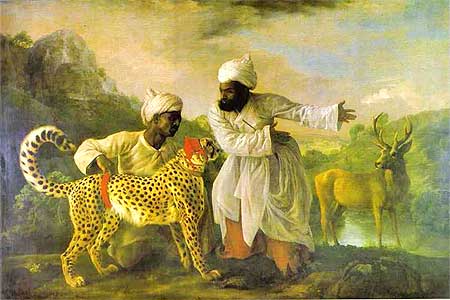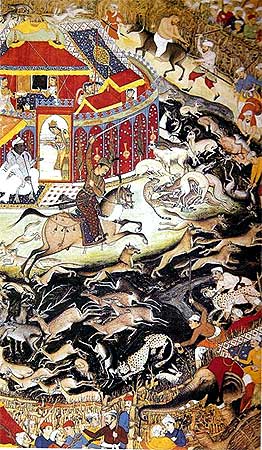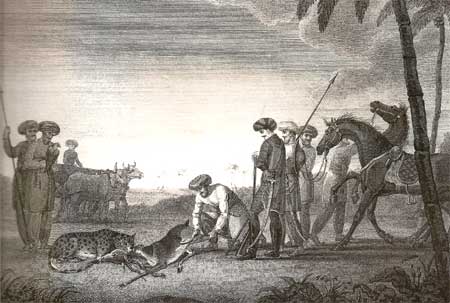Photographs: Courtesy Wikicommons
The word cheetah is Indian. It has its roots in Sanskrit. It means speckled.
But to the world at large the cheetah is considered an African animal.
It is estimated that just 60 cheetahs or less still live in Asia. Luke Hunter of the Wildife Conservation Society, a biologist who tracks this very rare animal, estimated, in an interview to NPR recently, that just 60 to100 extremely shy Asian cheetahs live in a remote arid area of Iran called the Kavir Desert.
But if India's newly-appointed environment minister Jairam Ramesh has his way this situation might change. Ramesh has plans to import this animal into India from Africa and re-introduce it to Indian habitat.
Cheetahs once roamed India and Asia up to Israel and even parts of Europe extensively in addition to Africa as is evident from this portrait of a cheetah and two attendants by British painter George Stubbs. This particular cheetah was gifted to Britain's George III by Madras governor Sir George Pigot. Divyabhanusinh in his detailed account of the Indian Cheetah, The End of a Trail reports not very conclusive evidence of seals etched with the outlines of an animal that looked quite like the Indian cheetah in Mohenjadaro.
The spotted cat returns?
Image: Cheetahs, called hunter leopards by the British, were popular for hunting for their swiftnessPhotographs: Courtesy Wikicommons
According Thomas T Allsen's The Royal Hunt in Eurasian History as well as W T Blanford's The Fauna of British India, hunting with cheetahs was an age-old sport of the Indian subcontinent, particularly all across the Deccan plateau.
Indian royalty, through the ages, tamed these regal and swift beasts quite easily, especially the females of the species and took them on antelope hunts. Life with an Indian Prince has a scene of this sport.
Mughal miniatures testify that Emperor Akbar had apparently 1,000 trained cheetahs and according other estimates kept many more than that during his 45 year reign.
Tipu Sultan, who called himself the Tiger of Mysore, had 16 hunting cheetahs that each had a retinue of their own. Hunts were very ceremonial in Tipu's Srirangapatnam and upto eight cloaked cheetahs rode out with their train in a hunting party. Only when the group was within a few hundred yards of a deer were the cheetahs uncloaked and allowed to hunt the deer down. The head huntsmen then took charge of the prey and killed it.
The spotted cat returns?
Image: A miniature of Akbar hunting with cheetahsPhotographs: From the Akbarnama. Courtesy WIkicommons
Trapping of female cheetahs -- apart from the massacre of cheetahs in the wild by hunters -- led to the extinction of the Indian cheetah.
Cheetahs do not breed well in captivity (modern zoos have the same issues) and the tamed cheetahs did not produce litters.
Additionally the Asian cheetah was a fragile animal susceptible to disease and was winnowed out in northern parts of the subcontinent (in Pakistan, Baluchistan and parts of Iran) by the drastic reduction of their habitat and poaching.
The spotted cat returns?
Image: Cheetah Cubs and dog, a photograph taken by Major G S Rodon in Dharwar, Karnataka, in 1897Photographs: Courtesy Journal of the Bombay Natural History, Vol XI
"The cheetah is the only animal to have been declared extinct in India in the last 1,000 years. We have to get them from abroad to repopulate the species here," Ramesh recently said.
The minister has authorised a study to investigate the feasibility of bringing this magnificent mammal back to India following a proposal and presentation of a plan by the World Wildllife Fund.
The genetic differences between the African and Asian cheetah are apparently minor and it is hoped that a cheetah from Africa could adjust to India's environment.
The spotted cat returns?
Image: Hunting the black buck with a cheetah, a sketch byJames Forbes in South GujaratPhotographs: Courtesy Oriental Memoirs, Vol. I, 1812
Should Ramesh's plan see the light of day and cheetah once again find a home in the subcontinent, India will once again be home to four of the world's most magnificent cats -- the tiger, the lion, the leopard and the cheetah.
And the clock will be turned back from that sad day in 1947 when the Maharaja of Surguja apparently shot India's last three cheetahs in Chattisgarh.






article